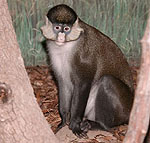Other Monkeys We Saw
Click here for the Black and White Colobus.
Click here for the Blue Monkey.
Click here for the Vervet Monkey.
RED-TAILED MONKEY

How to Recognize
Red-tailed monkeys are relatively small primates. They have a
black face, bluish skin around their eyes, a white spot on their nose, and white cheek fur.
The name 'redtail'
comes from the chestnut-colored fur on the underside of their tails. The rest of their bodies are
covered with a
speckled brown coat with gray or black limbs.
Habitat
Red-tailed monkeys can live in a rather large variety of habitats. They are mainly found in the middle
canopy of tropical rainforests. However, they have also been observed in swamp forests,
secondary forests, ravine gallery forest, and other woodlands.
Behavior
Diurnal. Red-tailed monkeys are quite agile and active. Their main hours of activity are in the
early morning or late evening.
Red-tailed monkeys tend to be found in medium-sized groups of 11 to 14 females
and one male. It's common for several of these
troops to congregate together at food resources or in large trees during resting periods.
Groups of red-tailed monkeys travel approximately a mile each day in search of food. Groups defend
their home ranges of about 300 acres primarily through visual threats and, if necessary,
physical combat.
Red-tailed monkeys are commonly found in close association with other primate species, such as red colobus,
mangabey, and blue monkeys. The have also been observed interacting socially
with these species, playing, grooming, and helping in defense from common predators. Red-tailed monkeys
have also been observed mating with blue monkeys which produces fertile offspring. (Would these be
purple monkeys?! Ha, ha.)
Breeding
Red-tailed monkeys generally breed throughout the year, although the peak season is from November to
February.
The majority of pregnancies produce a single infant.
Males generally reach sexual maturity at the age of six, with females maturing at four or five years of
age.
Feeding
Red-tailed monkeys mainly eat fruit, but supplement their diet with leaves, insects, flowers,
buds, and gum.
It's common for adults to store fruit in their large cheek pouches in order to take their meal to
an area free from the threat of theft by other monkeys.
Red-tailed monkeys form an important feeding association with colobus monkeys. It seems that colobus monkeys bite
through the tough outer
skin of Mondura fruit, and then the red-tailed monkeys are able to eat the fruit scraps that
contain ordinarily
unobtainable fruit pulp.
Enemies
Red-tailed monkeys are potential prey for chimpanzees,
crowned hawk-eagles, wild cats, and humans. Their populations are depleted by distraught
farmers that view them as pests and shoot them upon sight.
TOP OF PAGE
Copyright © 2002, Dawn M. Dalton.
All rights reserved.
**LINKS**
WHERE?
WHY?
ITINERARY
PLAN YOUR TRIP
GETTING THERE
LONDON
KENYA
UGANDA
SAFETY
ITEMS BOUGHT
STAYING HEALTHY
COMMENTS
HOME
BHS HOME
---Animal Facts--
Baboon
Buffalo
Cheetah
Chimpanzee
Crocodile
Eland
Elephant
Gazelle
Giant Forest Hog
Giraffe
Gorilla
Hippopotamus
Hyena
Hyrax
Impala
Jackal
Lion
Mongoose
Monkey
Ostrich
Rhinoceros
Topi
Uganda Kob
Warthog
Waterbuck
Wildebeest
Zebra